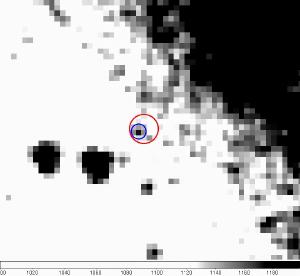Post
The Sleeper Awakens
2 August 2013
The image below was taken by the Spitzer infrared space telescope in 2004. It shows what appears to be a red supergiant star in the galaxy known as M74, about 30 million light years away. It isn’t a particularly good image, because in 2004 it was just a red supergiant in a typical galaxy. There are billions of such stars in the universe, and its image was only captured because we do survey images of galaxies and such.
Of course one of the reasons we do these surveys is because of what happened last week. On July 25, astronomers from the Lick Observatory Supernova Search identified a 13.5 magnitude star that appeared to be a new supernova. Further observations confirmed it as such. Measurements of its location are indicated by the red and blue circles in the image below. As you can see, the supernova is centered right at the red supergiant, making it the strong candidate progenitor.
 Lick Observatory
Lick ObservatoryThere are different types of supernovae. They were originally categorized as type I and type II based on the detection of hydrogen emission lines in the light emitted by the supernova. Type I had little or no measurable hydrogen, while type II had hydrogen. Later we came to understand that a subgroup of type I (known as type Ia) was a supernova caused when a white dwarf star accumulates gas from a binary partner until it undergoes a rapid explosion.
The other type I and type II supernovae are “core collapse” supernovae, meaning they occur when a large star runs out of hydrogen to burn, and collapses upon itself resulting in the core rapidly heating and tearing the star apart. Such stars enter a red supergiant stage before going supernova, so if this particular red supergiant is the progenitor, then the supernova should be type II.
Which it is, since hydrogen lines have been identified in the light of the supernova. So the image below is of a star on the verge of dying. Within a decade it exploded with a brilliance that outshines its home galaxy.
The sleeper has awakened.